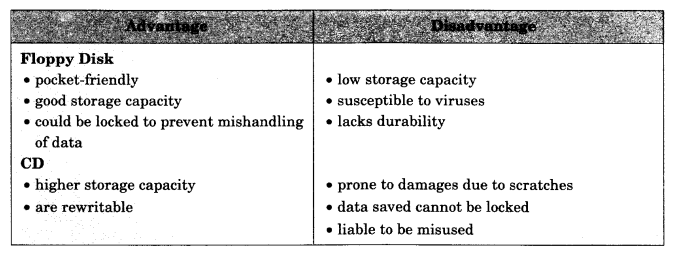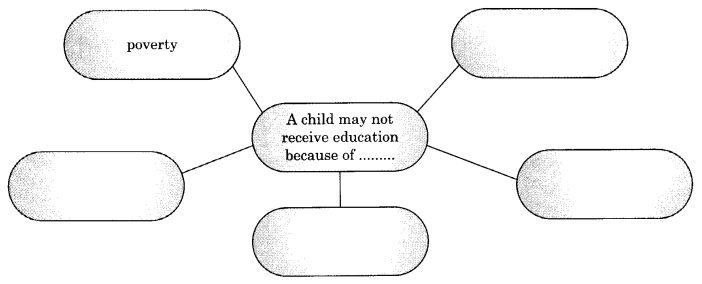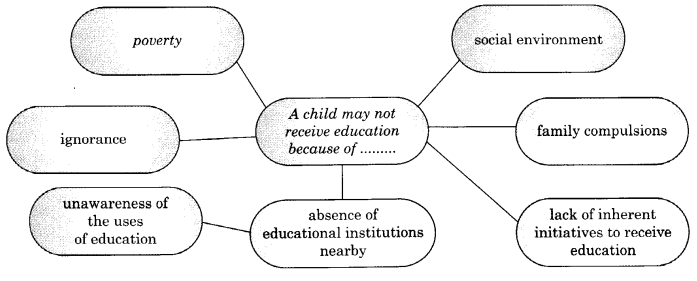NCERT Solutions for Class 10 English Main Course Book Unit 4 Chapter 5 Geological Heritage are part of NCERT Solutions for Class 10 English. Here we have given NCERT Solutions for Class 10 English Main Course Book Unit 4 Chapter 5 Geological Heritage.
| Board | CBSE |
| Textbook | NCERT |
| Class | Class 10 |
| Subject | English Main Course Book |
| Chapter | Unit 4 Chapter 5 |
| Chapter Name | Geological Heritage |
| Category | NCERT Solutions |
CBSE Class 10 English Main Course Book Unit 4 Environment Chapter 5 Geological Heritage
TEXTUAL EXERCISES
Working to save a Geological Heritage
Question 1.
Look at the photograph given below. This is The Three Stooges, a bizarre rock formation that can be found in Goblin Valley. There are some exceptionally unique rock formations all over the world.
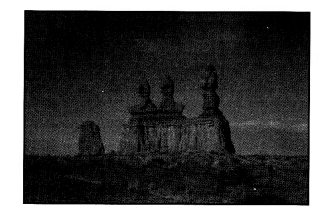
A. Why do you feel such geological structures should be preserved?
(a) _______________________________________
(b) _______________________________________
(c) _______________________________________
Answer:
(a) They reflect our glorious past.
(b) They are our national heritage.
(c) They can be places of tourists’ attraction.
B. What are the threats to such structures ?
(a) _______________________________________
(b) _______________________________________
(c) _______________________________________
Answer:
(a) Global warming
(b) Natural disasters
(c) Weathering and erosion.
(d) Using stones or rocks as building material in towns and cities.
Question 2.
The box below contains ten words from the passage. Use them appropriately to fill the blanks in the sentences that follow :

1. While food production has shown only marginal improvement, the demand for food grains, vegetables and fruits has registered an ______ growth the world over, forcing governments to initiate urgent measures to establish a balance between supply and demand.
2. To construct the ______ structure, the builder had to use enormous quantities of concrete.
3. When he returned from the office, he ______ himself in an armchair and asked for a cup of tea.
4. When the teacher saw a student perched ______ on the branch of a tree, she asked him to climb down immediately.
5. The newly appointed office assistant earned the praise of her colleagues for the ______ with which she completed the tasks assigned to her.
6. The new office building was ______ with its bright and fashionable exterior.
7. The pensioner did not get his dues in time on account of the ______ of the officials.
8. The land ______ the post office was procured by the authorities for expanding the building that housed it.
9. Merchants stock up on goods during festival seasons to meet the ______ demand and declare discounts when the sales slacken.
10. During wars armies dig up ______ passages for the movement of troops and supplies unseen by the enemy.
Answer:
- exponential
- mammoth
- ensconced
- precariously
- alacrity
- snazzy
- apathy
- abutting
- booming
- subterranean
Question 3.
On the basis of your comprehension of the text fill in the following table.
Answer:
(a) Importance of rocks
Aesthetic importance :
(a) True heritage of Hyderabad
(b) Fascinating shapes
(c) Mind-capturing
Ecological importance :
(a) Helpful in formation of lakes and ponds
(b) Create natural drainage system of the area
(c) Preserve and nurture bio-diversity and ecological balance
(b) Threats to the geological heritage.
Causes
- Expansion of cities
- Illegal and indiscriminate quarrying
Effects
- Depletion of green cover, flora and fauna.
- Depletion of underground water table.
(c) The hope
(i) The efforts of ‘Society to Save Rocks’ led to ……….
the addition of nine rock formations in Regulation No. 13 of Hyderabad Urban Development Authority for the protection of Heritage Buildings Precincts.
(i.i) Challenge to the efforts of‘Society to Save Rocks’ comes in the form of …………..
indifference and apathy of government to conserve rocks as well as conflict between development and protection in the city.
(ii) Individuals have made efforts to preserve the heritage by ………….
integrating rocks by the side of their houses into the structures of their homes and interiors.
Question 4.
Select a historical site in need of conservation, research about its historical significance, identify the threatening factors and suggest ways of preserving the geological heritage. Prepare a power point presentation and make a presentation to the class. (This can be done in groups)
Answer:
POWER POINT PRESENTATION ON RAM SETHU
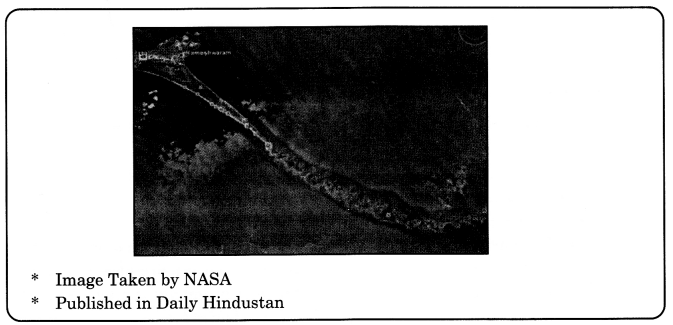
- Image Taken by NASA
- Published in Daily Hindustan
Ram Sethu
- Space images taken by NASA reveal a mysterious ancient bridge in the Palk Strait between India and Sri Lanka. The recently discovered bridge currently named as Adam’s Bridge is made of chain of shoals, c. 18 mi (30 km) long.
Historical Significance :
- The bridge’s unique curvature and composition by age reveals that it is man-made. The legends as well as Archaeological studies reveal that the first signs of human inhabitants in Sri Lanka date back to the primitive age, about 1,750,000 years ago and the bridge’s age is also almost equivalent.
Sri Rama and history of Ram Sethu
- Sri Ram was born three yugas ago as per Hindu religious books, so there could be places of the era of Sri Ram. The fact that there was a monument built during the era of Sri Ram was very heartening and encouraging.
Contemporary Researches :
- Geological Survey of India (GSI) has sent a team of scientists to Rameswaram to confirm the authenticity of the picture of RAM SETHU taken by NASA.
- The GSI team, having reached Rameswaram, Dhanushkodi and studying the place shown in the picture, confirmed the underwater formation of rocks attached to each other and described those rocks as old as one lakh years. For further study and excavation, they proposed a detailed project involving marine and scientific assistance and a budget of ₹ 100 crore.
Threatening Factors and Efforts to protect the Ram Sethu
- The news that Sethusamundram Project will be implemented by destroying Ram Sethu is like a severe jolt to us all.
- People and many NGO’s are launching movements against the Sethusamudram Project all over India.
- Every effort is being done to Protect Ram Sethu.
- The destruction of Ram Sethu is not only an insult to Indian culture, but it will also deprive lakhs of fishermen of their livelihood.
- We will have to fight for the cause of protection of Ram Sethu using our united powers.
Question 5.
Prepare a poster on ‘Let’s Preserve Our Heritage’
Remember
- to include both textual and graphic elements
- to make it easy to read
- to make it easy to understand
- to try for :
20% text
40% graphics
40% empty space
Answer:
Students to prepare a poster keeping in mind the above and using the above information. One is given on the next page.
POSTER

We hope the NCERT Solutions for Class 10 English Main Course Book Unit 4 Chapter 5 Geological Heritage help you. If you have any query regarding NCERT Solutions for Class 10 English Main Course Book Unit 4 Chapter 5 Geological Heritage, drop a comment below and we will get back to you at the earliest.
